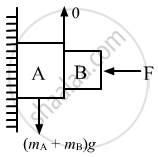Advertisements
Advertisements
प्रश्न
Consider the situation shown in figure. The wall smooth but the surface of A and B in contact are rough. The friction on B due to A in equilibrium

विकल्प
is upward
is downward
is zero
the system cannot remain in equilibrium.
उत्तर
the system cannot remain in equilibrium.
Since the wall is smooth and the surface of A and B in contact are rough, the net vertical force on the system is in the downward direction. Hence, the system cannot remain in equilibrium.
APPEARS IN
संबंधित प्रश्न
For most of the surfaces used in daily life, the friction coefficient is less than 1. Is it always necessary that the friction coefficient is less than 1?
Why is it easier to push a heavy block from behind than to press it on the top and push?
What is the average friction force when a person has a usual 1 km walk?
Why is it difficult to walk on solid ice?
Spring fitted doors close by themselves when released. You want to keep the door open for a long time, say for an hour. If you put a half kg stone in front of the open door, it does not help. The stone slides with the door and the door gets closed. However, if you sandwitch a 20 g piece of wood in the small gap between the door and the floor, the door stays open. Explain why a much lighter piece of wood is able to keep the door open while the heavy stone fails.
A classroom demonstration of Newton's first law is as follows : A glass is covered with a plastic card and a coin is placed on the card. The card is given a quick strike and the coin falls in the glass. (a) Should the friction coefficient between the card and the coin be small or large? (b) Should the coin be light or heavy? (c) Why does the experiment fail if the card is gently pushed?
Can a tug of war be ever won on a frictionless surface?
Why do tyres have a better grip of the road while going on a level road than while going on an incline?
You are standing with your bag in your hands, on the ice in the middle of a pond. The ice is so slippery that it can offer no friction. How can you come out of the ice?
When two surfaces are polished, the friction coefficient between them decreases. But the friction coefficient increases and becomes very large if the surfaces are made highly smooth. Explain.
While walking on ice, one should take small steps to avoid slipping. This is because smaller steps ensure
Suppose all the surface in the previous problem are rough. The direction of friction of B due to A
